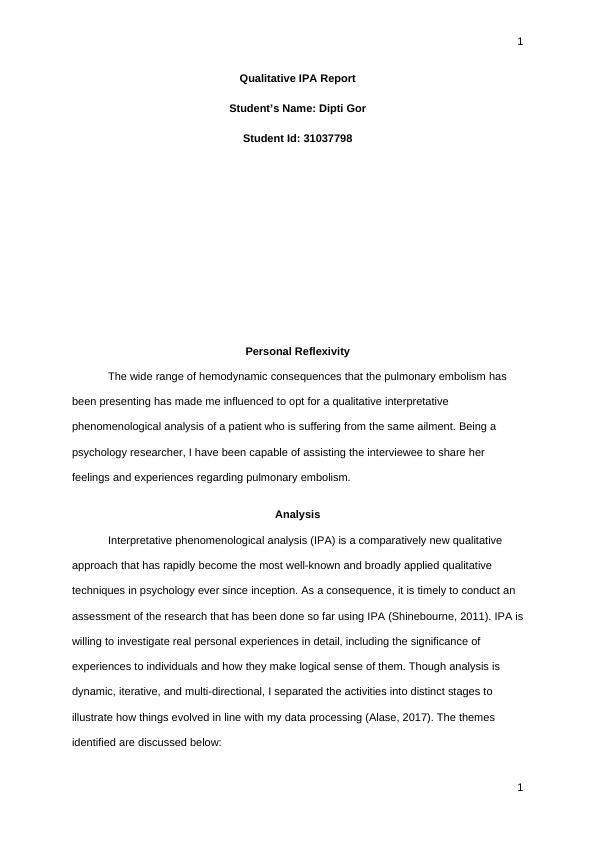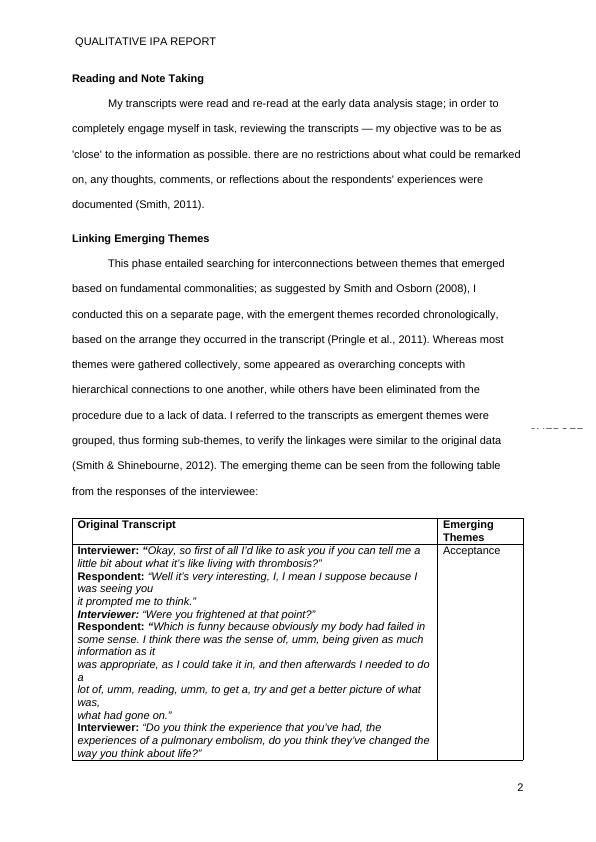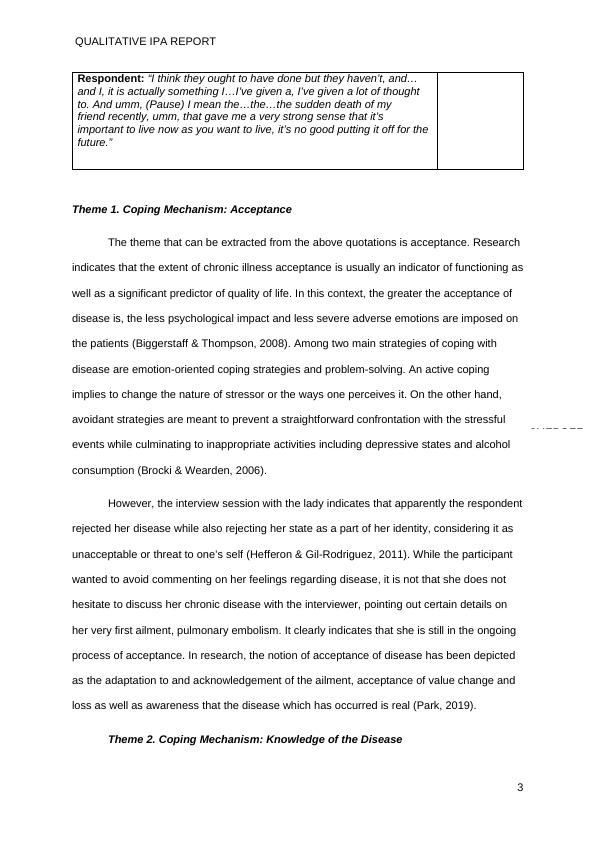Personal Reflexivity Report 2022
Added on 2022-09-28
10 Pages3392 Words30 Views
1
Qualitative IPA Report
Student’s Name: Dipti Gor
Student Id: 31037798
Personal Reflexivity
The wide range of hemodynamic consequences that the pulmonary embolism has
been presenting has made me influenced to opt for a qualitative interpretative
phenomenological analysis of a patient who is suffering from the same ailment. Being a
psychology researcher, I have been capable of assisting the interviewee to share her
feelings and experiences regarding pulmonary embolism.
Analysis
Interpretative phenomenological analysis (IPA) is a comparatively new qualitative
approach that has rapidly become the most well-known and broadly applied qualitative
techniques in psychology ever since inception. As a consequence, it is timely to conduct an
assessment of the research that has been done so far using IPA (Shinebourne, 2011). IPA is
willing to investigate real personal experiences in detail, including the significance of
experiences to individuals and how they make logical sense of them. Though analysis is
dynamic, iterative, and multi-directional, I separated the activities into distinct stages to
illustrate how things evolved in line with my data processing (Alase, 2017). The themes
identified are discussed below:
1
Qualitative IPA Report
Student’s Name: Dipti Gor
Student Id: 31037798
Personal Reflexivity
The wide range of hemodynamic consequences that the pulmonary embolism has
been presenting has made me influenced to opt for a qualitative interpretative
phenomenological analysis of a patient who is suffering from the same ailment. Being a
psychology researcher, I have been capable of assisting the interviewee to share her
feelings and experiences regarding pulmonary embolism.
Analysis
Interpretative phenomenological analysis (IPA) is a comparatively new qualitative
approach that has rapidly become the most well-known and broadly applied qualitative
techniques in psychology ever since inception. As a consequence, it is timely to conduct an
assessment of the research that has been done so far using IPA (Shinebourne, 2011). IPA is
willing to investigate real personal experiences in detail, including the significance of
experiences to individuals and how they make logical sense of them. Though analysis is
dynamic, iterative, and multi-directional, I separated the activities into distinct stages to
illustrate how things evolved in line with my data processing (Alase, 2017). The themes
identified are discussed below:
1

2MERGEF
QUALITATIVE IPA REPORT
Reading and Note Taking
My transcripts were read and re-read at the early data analysis stage; in order to
completely engage myself in task, reviewing the transcripts — my objective was to be as
'close' to the information as possible. there are no restrictions about what could be remarked
on, any thoughts, comments, or reflections about the respondents' experiences were
documented (Smith, 2011).
Linking Emerging Themes
This phase entailed searching for interconnections between themes that emerged
based on fundamental commonalities; as suggested by Smith and Osborn (2008), I
conducted this on a separate page, with the emergent themes recorded chronologically,
based on the arrange they occurred in the transcript (Pringle et al., 2011). Whereas most
themes were gathered collectively, some appeared as overarching concepts with
hierarchical connections to one another, while others have been eliminated from the
procedure due to a lack of data. I referred to the transcripts as emergent themes were
grouped, thus forming sub-themes, to verify the linkages were similar to the original data
(Smith & Shinebourne, 2012). The emerging theme can be seen from the following table
from the responses of the interviewee:
Original Transcript Emerging
Themes
Interviewer: “Okay, so first of all I’d like to ask you if you can tell me a
little bit about what it’s like living with thrombosis?”
Respondent: “Well it’s very interesting, I, I mean I suppose because I
was seeing you
it prompted me to think.”
Interviewer: “Were you frightened at that point?”
Respondent: “Which is funny because obviously my body had failed in
some sense. I think there was the sense of, umm, being given as much
information as it
was appropriate, as I could take it in, and then afterwards I needed to do
a
lot of, umm, reading, umm, to get a, try and get a better picture of what
was,
what had gone on.”
Interviewer: “Do you think the experience that you’ve had, the
experiences of a pulmonary embolism, do you think they’ve changed the
way you think about life?”
Acceptance
2
QUALITATIVE IPA REPORT
Reading and Note Taking
My transcripts were read and re-read at the early data analysis stage; in order to
completely engage myself in task, reviewing the transcripts — my objective was to be as
'close' to the information as possible. there are no restrictions about what could be remarked
on, any thoughts, comments, or reflections about the respondents' experiences were
documented (Smith, 2011).
Linking Emerging Themes
This phase entailed searching for interconnections between themes that emerged
based on fundamental commonalities; as suggested by Smith and Osborn (2008), I
conducted this on a separate page, with the emergent themes recorded chronologically,
based on the arrange they occurred in the transcript (Pringle et al., 2011). Whereas most
themes were gathered collectively, some appeared as overarching concepts with
hierarchical connections to one another, while others have been eliminated from the
procedure due to a lack of data. I referred to the transcripts as emergent themes were
grouped, thus forming sub-themes, to verify the linkages were similar to the original data
(Smith & Shinebourne, 2012). The emerging theme can be seen from the following table
from the responses of the interviewee:
Original Transcript Emerging
Themes
Interviewer: “Okay, so first of all I’d like to ask you if you can tell me a
little bit about what it’s like living with thrombosis?”
Respondent: “Well it’s very interesting, I, I mean I suppose because I
was seeing you
it prompted me to think.”
Interviewer: “Were you frightened at that point?”
Respondent: “Which is funny because obviously my body had failed in
some sense. I think there was the sense of, umm, being given as much
information as it
was appropriate, as I could take it in, and then afterwards I needed to do
a
lot of, umm, reading, umm, to get a, try and get a better picture of what
was,
what had gone on.”
Interviewer: “Do you think the experience that you’ve had, the
experiences of a pulmonary embolism, do you think they’ve changed the
way you think about life?”
Acceptance
2

2MERGEF
QUALITATIVE IPA REPORT
Respondent: “I think they ought to have done but they haven’t, and...
and I, it is actually something I...I’ve given a, I’ve given a lot of thought
to. And umm, (Pause) I mean the...the...the sudden death of my
friend recently, umm, that gave me a very strong sense that it’s
important to live now as you want to live, it’s no good putting it off for the
future.”
Theme 1. Coping Mechanism: Acceptance
The theme that can be extracted from the above quotations is acceptance. Research
indicates that the extent of chronic illness acceptance is usually an indicator of functioning as
well as a significant predictor of quality of life. In this context, the greater the acceptance of
disease is, the less psychological impact and less severe adverse emotions are imposed on
the patients (Biggerstaff & Thompson, 2008). Among two main strategies of coping with
disease are emotion-oriented coping strategies and problem-solving. An active coping
implies to change the nature of stressor or the ways one perceives it. On the other hand,
avoidant strategies are meant to prevent a straightforward confrontation with the stressful
events while culminating to inappropriate activities including depressive states and alcohol
consumption (Brocki & Wearden, 2006).
However, the interview session with the lady indicates that apparently the respondent
rejected her disease while also rejecting her state as a part of her identity, considering it as
unacceptable or threat to one’s self (Hefferon & Gil-Rodriguez, 2011). While the participant
wanted to avoid commenting on her feelings regarding disease, it is not that she does not
hesitate to discuss her chronic disease with the interviewer, pointing out certain details on
her very first ailment, pulmonary embolism. It clearly indicates that she is still in the ongoing
process of acceptance. In research, the notion of acceptance of disease has been depicted
as the adaptation to and acknowledgement of the ailment, acceptance of value change and
loss as well as awareness that the disease which has occurred is real (Park, 2019).
Theme 2. Coping Mechanism: Knowledge of the Disease
3
QUALITATIVE IPA REPORT
Respondent: “I think they ought to have done but they haven’t, and...
and I, it is actually something I...I’ve given a, I’ve given a lot of thought
to. And umm, (Pause) I mean the...the...the sudden death of my
friend recently, umm, that gave me a very strong sense that it’s
important to live now as you want to live, it’s no good putting it off for the
future.”
Theme 1. Coping Mechanism: Acceptance
The theme that can be extracted from the above quotations is acceptance. Research
indicates that the extent of chronic illness acceptance is usually an indicator of functioning as
well as a significant predictor of quality of life. In this context, the greater the acceptance of
disease is, the less psychological impact and less severe adverse emotions are imposed on
the patients (Biggerstaff & Thompson, 2008). Among two main strategies of coping with
disease are emotion-oriented coping strategies and problem-solving. An active coping
implies to change the nature of stressor or the ways one perceives it. On the other hand,
avoidant strategies are meant to prevent a straightforward confrontation with the stressful
events while culminating to inappropriate activities including depressive states and alcohol
consumption (Brocki & Wearden, 2006).
However, the interview session with the lady indicates that apparently the respondent
rejected her disease while also rejecting her state as a part of her identity, considering it as
unacceptable or threat to one’s self (Hefferon & Gil-Rodriguez, 2011). While the participant
wanted to avoid commenting on her feelings regarding disease, it is not that she does not
hesitate to discuss her chronic disease with the interviewer, pointing out certain details on
her very first ailment, pulmonary embolism. It clearly indicates that she is still in the ongoing
process of acceptance. In research, the notion of acceptance of disease has been depicted
as the adaptation to and acknowledgement of the ailment, acceptance of value change and
loss as well as awareness that the disease which has occurred is real (Park, 2019).
Theme 2. Coping Mechanism: Knowledge of the Disease
3

End of preview
Want to access all the pages? Upload your documents or become a member.
Related Documents
Differences between structured and semi-structured interviews, advantages of semi-structured interviews, and thematic analysis of friendship themes in universitylg...
|4
|840
|274
An Interpretative Phenomenological Analysislg...
|5
|642
|493
Business Research Assignment - HI6008 Assignmentlg...
|8
|1751
|27
